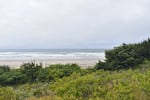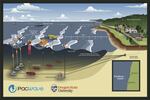
The work on the OSU led wave energy test site will be taking place for most of August off of the coast near Driftwood Beach State Recreation Site near Waldport.
Oregon State University
Oregon State University is constructing a wave energy testing facility off the Oregon Coast and, weather permitting, some of that work will be visible from shore this month.
PacWaveSouth will be the first utility-scale, grid-connected wave energy test site in the U.S. It’s been about a decade of permitting, siting and design, according to OSU Oceanography professor Burke Hales. He’s the chief scientist with PacWave.
“We will have a large vessel. It’s called the Seacor Lee (and) she’s out of Anacortes, Washington,” said Hales. “She will make a brief stop in Newport’s Yaquina Bay. And then be out on site for most of the rest of August. Initially, she’ll be very close to shore, just about a mile offshore of Driftwood Beach State Recreation Site, which is just south of Seal Rock, just north of Waldport on the Oregon Coast.”
Portions of the parking area at Driftwood Beach State Recreation Site will be closed to the public while the work is underway.
“From the beach, that vessel will appear very very close. The vessel will be anchored out there and will be supporting divers who will be preparing the ends of those conduits to be conducive to pulling the cables in next summer,” said Hale.

A rendering of what PacWave South will look like.
Oregon State University
Hales said workers will prepare undersea floor conduits for installation of power and data cables. The cables, each about 12 miles long, are being manufactured in Norway, by the Paris-based firm Nexans. PacWave, once built, will provide wave energy developers a way to test their devices.
“That’s what the test facility allows users to do,” said Hale. “Is to build their devices, bring them out there, anchor them, connect them to the cable, which connects back to the grid and then start putting power back into the power grid.”
Hale said the test facility is being set up so the amount of power produced by wave energy can be quantified.
“The really tricky part is how efficiently does the device extract that power from the waves?” Hales asked. “How efficiently does it convert it to electricity? And how efficiently does it transmit that electricity back to the grid where it can be used?”
Once tested, those devices will likely be moved somewhere else, to produce energy, like Southern California, or off the coast of Alaska.
Hales said the The PacWave test facility is permitted by the Federal Energy Regulatory Commission, or FERC, and the property is under lease for 25 years. He added that the permitting process included a number of federal and state agencies, including NOAA, Oregon Parks, the Army Corps of Engineers, and the Oregon Department of Environmental Quality. They also consulted with marine researchers to ensure the facility will not disturb marine life.
Hales said they have a long term commitment to monitoring the environment, including acoustic conditions. He said the facility shouldn’t be making noise that would affect marine mammal life.
“But, we have an extensive array of devices, cutting edge technology that will assess the background acoustic signature and how it changes in response to new devices being brought on site,” said Hale. “We’ve got acoustic thresholds which, if exceeded, we have to respond.”
Another concern they’re addressing is entanglement. Hales said the devices are on taut tethers and anchors so that it should be very hard for marine mammals to get tangled in them.
He added that the project is working with the commercial fishing industry. The PacWave facility is outside of fishing areas, but in stormy conditions, crab pots may get moved around into the site and could get tangled into a wave energy device. That could be a problem for the crab fishers and for the test facility.
“We have plans to mitigate the potential for entanglement,” said Hale.
The ship is scheduled to arrive on Monday at Yaquina Bay then make its way to the PacWave site several days later. Hales said to hope for calm seas while the work is underway.
PacWave South is supported by grants from the U.S. Department of Energy, the state of Oregon and other public and private entities. Oregon State’s College of Earth, Ocean, and Atmospheric Sciences is managing the construction and operation of the more than $80 million facility.
Copyright 2023 KLCC.